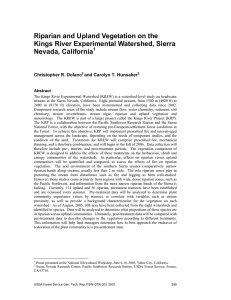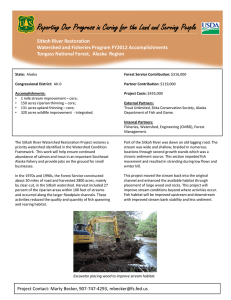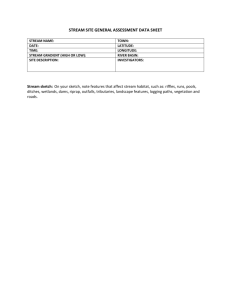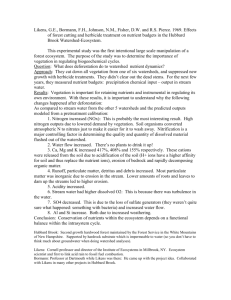Fuels Reduction Effects on Small Stream Ecosystems,
advertisement
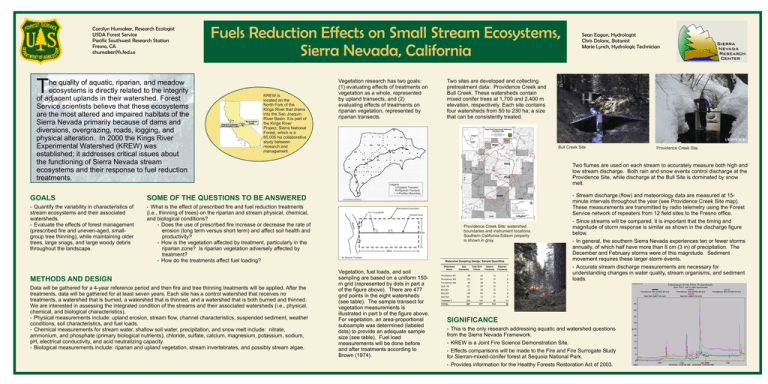
Carolyn Hunsaker, Research Ecologist USDA Forest Service Pacific Southwest Research Station Fresno, CA chunsaker@fs.fed.us T he quality of aquatic, riparian, and meadow ecosystems is directly related to the integrity of adjacent uplands in their watershed. Forest Service scientists believe that these ecosystems are the most altered and impaired habitats of the Sierra Nevada primarily because of dams and diversions, overgrazing, roads, logging, and physical alteration. In 2000 the Kings River Experimental Watershed (KREW) was established; it addresses critical issues about the functioning of Sierra Nevada stream ecosystems and their response to fuel reduction treatments. Fuels Reduction Effects on Small Stream Ecosystems, Sierra Nevada, California KREW is located on the North Fork of the Kings River that drains into the San Joaquin River Basin. It is part of the Kings River Project, Sierra National Forest, which is a 60,000 ha collaborative study between research and management. Vegetation research has two goals: (1) evaluating effects of treatments on vegetation as a whole, represented by upland transects, and (2) evaluating effects of treatments on riparian vegetation, represented by riparian transects. SOME OF THE QUESTIONS TO BE ANSWERED Quantify the variability in characteristics of stream ecosystems and their associated watersheds. • Evaluate the effects of forest management (prescribed fire and uneven-aged, smallgroup tree thinning), while maintaining older trees, large snags, and large woody debris throughout the landscape. What is the effect of prescribed fire and fuel reduction treatments (i.e., thinning of trees) on the riparian and stream physical, chemical, and biological conditions? • Does the use of prescribed fire increase or decrease the rate of erosion (long term versus short term) and affect soil health and productivity? • How is the vegetation affected by treatment, particularly in the riparian zone? Is riparian vegetation adversely affected by treatment? • How do the treatments affect fuel loading? • U U U R U U U R U R Two flumes are used on each stream to accurately measure both high and low stream discharge. Both rain and snow events control discharge at the Providence Site, while discharge at the Bull Site is dominated by snow melt. R U R U Providence Creek Site U Legend: U=Upland Transect R=Riparian Transect =Partition Boundary (a)Transect Locations Belt transect boundary 1X1 m quadrats Transect axis Providence Creek Site: watershed boundaries and instrument locations. Southern California Edison property is shown in gray. 10m 20m (b) Sample Transect Watershed Sampling Design: Sample Quantities Vegetation, fuel loads, and soil sampling are based on a uniform 150m grid (represented by dots in part a of the figure above). There are 477 grid points in the eight watersheds (see table). The sample transect for vegetation measurements is illustrated in part b of the figure above. For vegetation, an area-proportional subsample was determined (labeled dots) to provide an adequate sample size (see table). Fuel load measurements will be done before and after treatments according to Brown (1974). Stream discharge (flow) and meteorology data are measured at 15minute intervals throughout the year (see Providence Creek Site map). These measurements are transmitted by radio telemetry using the Forest Service network of repeaters from 12 field sites to the Fresno office. • Since streams will be compared, it is important that the timing and magnitude of storm response is similar as shown in the discharge figure below. • In general, the southern Sierra Nevada experiences ten or fewer storms annually, of which half have more than 8 cm (3 in) of precipitation. The December and February storms were of this magnitude. Sediment movement requires these larger storm events. • Accurate stream discharge measurements are necessary for understanding changes in water quality, stream organisms, and sediment loads. • m Strea Data will be gathered for a 4-year reference period and then fire and tree thinning treatments will be applied. After the treatments, data will be gathered for at least seven years. Each site has a control watershed that receives no treatments, a watershed that is burned, a watershed that is thinned, and a watershed that is both burned and thinned. We are interested in assessing the integrated condition of the streams and their associated watersheds (i.e., physical, chemical, and biological characteristics). • Physical measurements include: upland erosion, stream flow, channel characteristics, suspended sediment, weather conditions, soil characteristics, and fuel loads. • Chemical measurements for stream water, shallow soil water, precipitation, and snow melt include: nitrate, ammonium, and phosphate (primary biological nutrients), chloride, sulfate, calcium, magnesium, potassium, sodium, pH, electrical conductivity, and acid neutralizing capacity. • Biological measurements include: riparian and upland vegetation, stream invertebrates, and possibly stream algae. Bull Creek Site R U • METHODS AND DESIGN Two sites are developed and collecting pretreatment data: Providence Creek and Bull Creek. These watersheds contain mixed conifer trees at 1,700 and 2,400 m elevation, respectively. Each site contains four watersheds from 50 to 230 ha; a size that can be consistently treated. U R GOALS Sean Eagan, Hydrologist Chris Dolanc, Botanist Marie Lynch, Hydrologic Technician Watershed Name Size (hectares) Total Grid Points Upland Transects Riparian Transects Providence 301 99 44 13 7 Providence 303 132 60 15 6 Providence 304 49 39 10 5 Duff 102 121 54 14 7 Bull 201 53 45 10 5 Bull 203 138 63 15 8 Bull 204 167 72 17 8 Teakettle 3 228 100 20 10 TOTAL 987 477 114 56 SIGNIFICANCE This is the only research addressing aquatic and watershed questions from the Sierra Nevada Framework. • KREW is a Joint Fire Science Demonstration Site. • Effects comparisons will be made to the Fire and Fire Surrogate Study for Sierran-mixed-conifer forest at Sequoia National Park. • Provides information for the Healthy Forests Restoration Act of 2003. •
